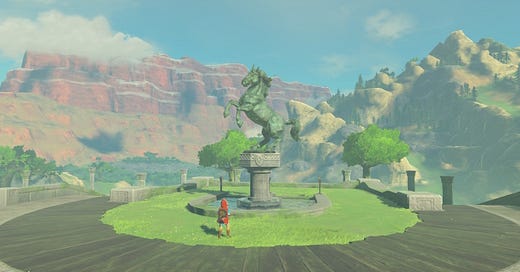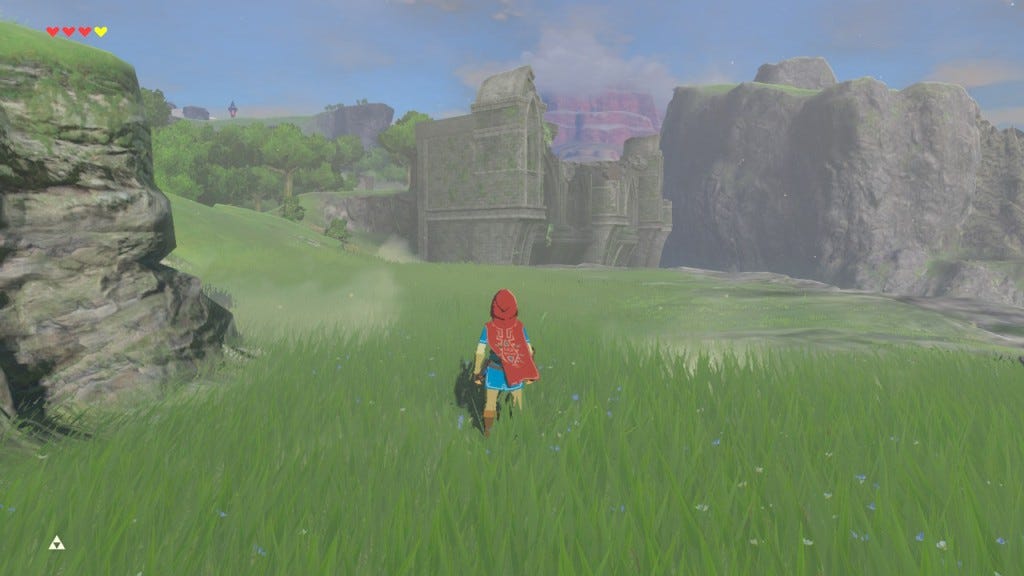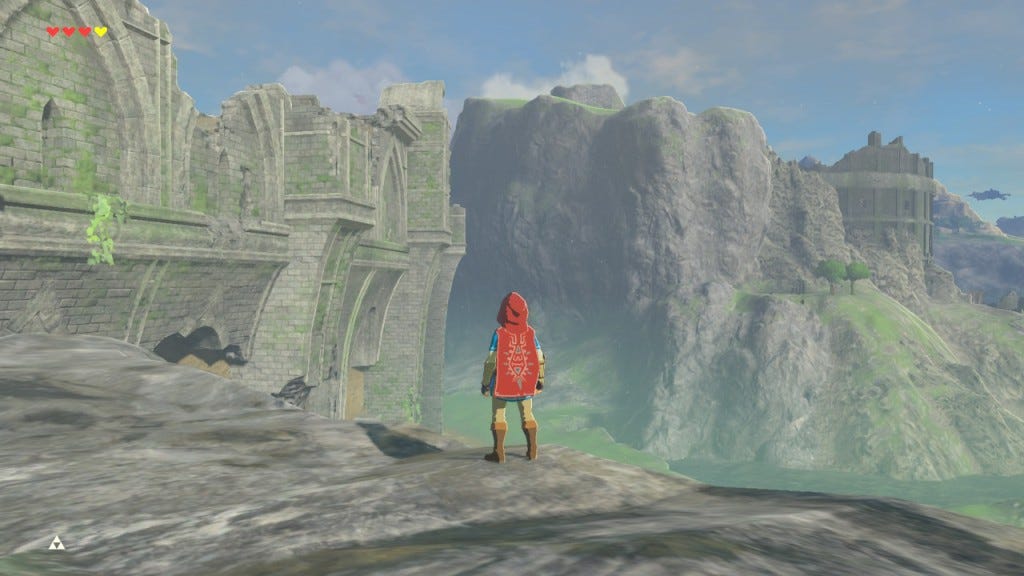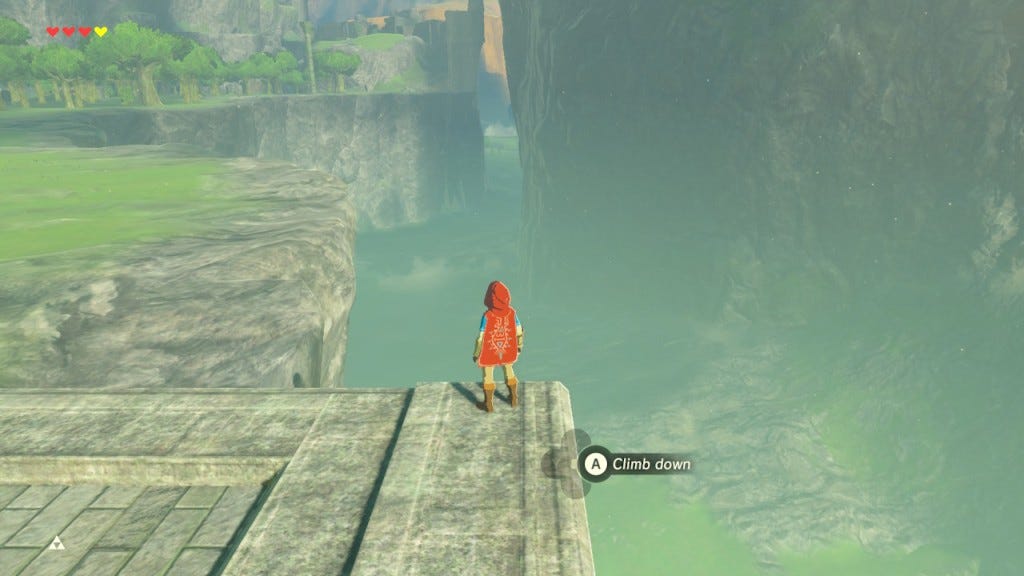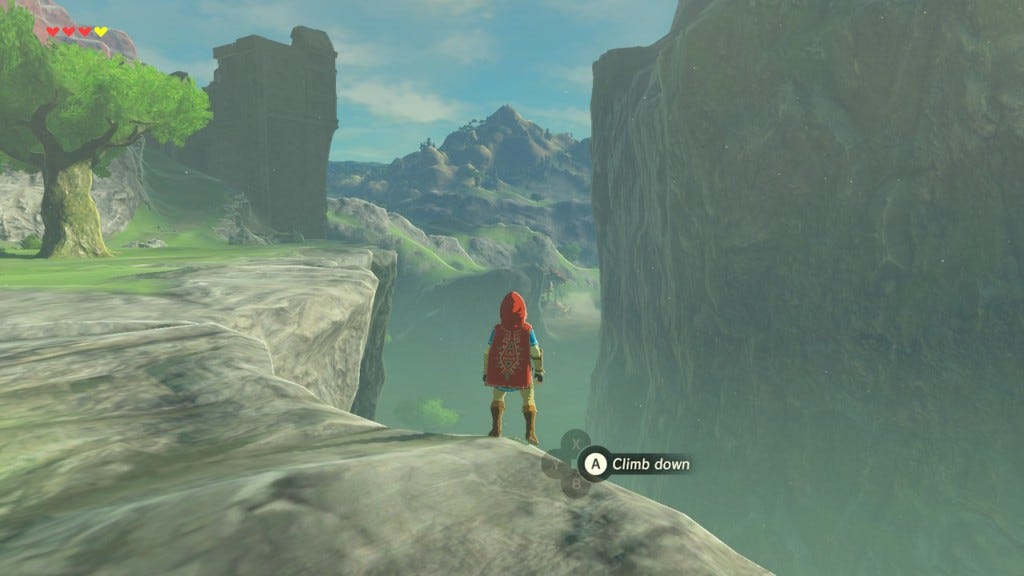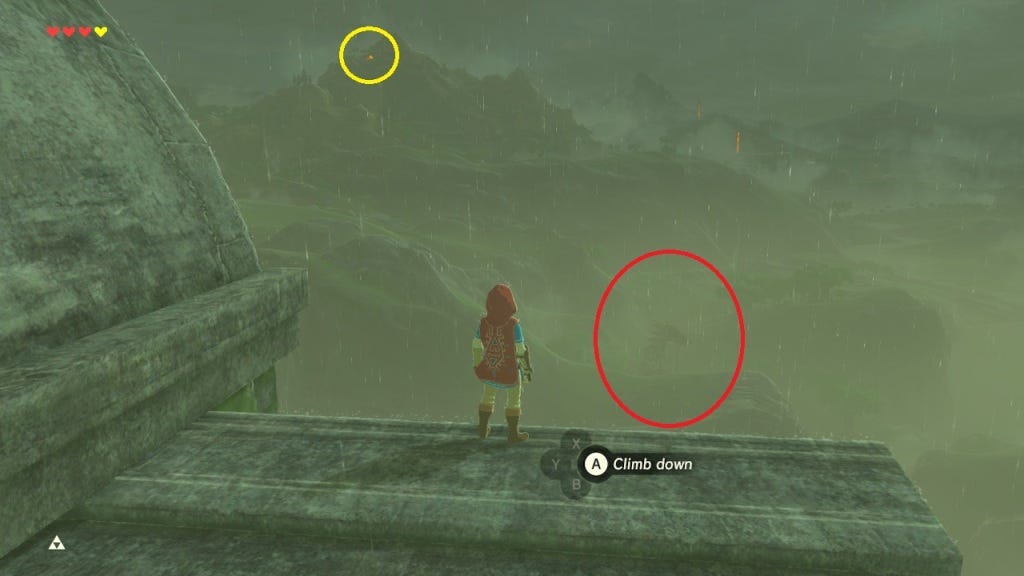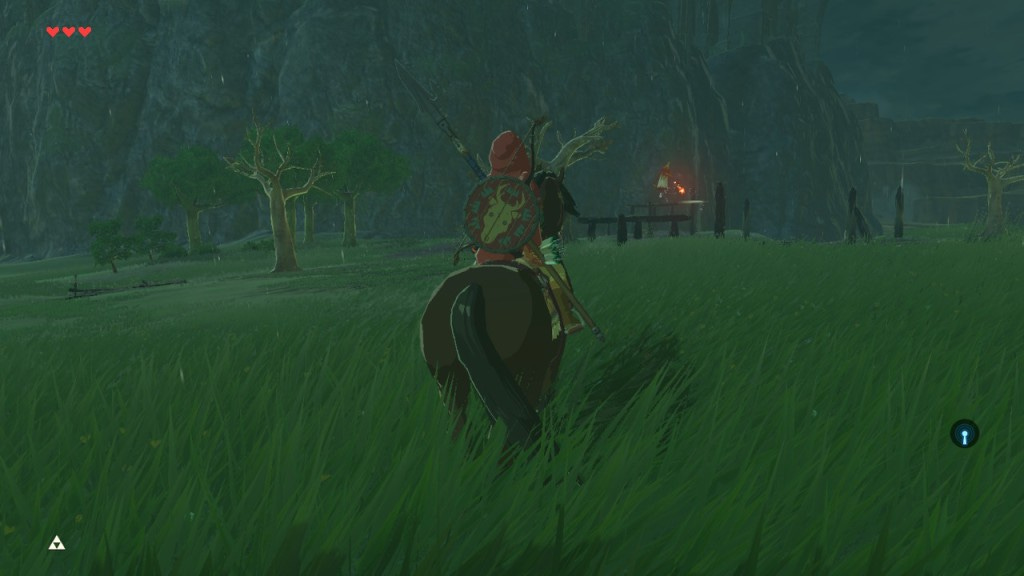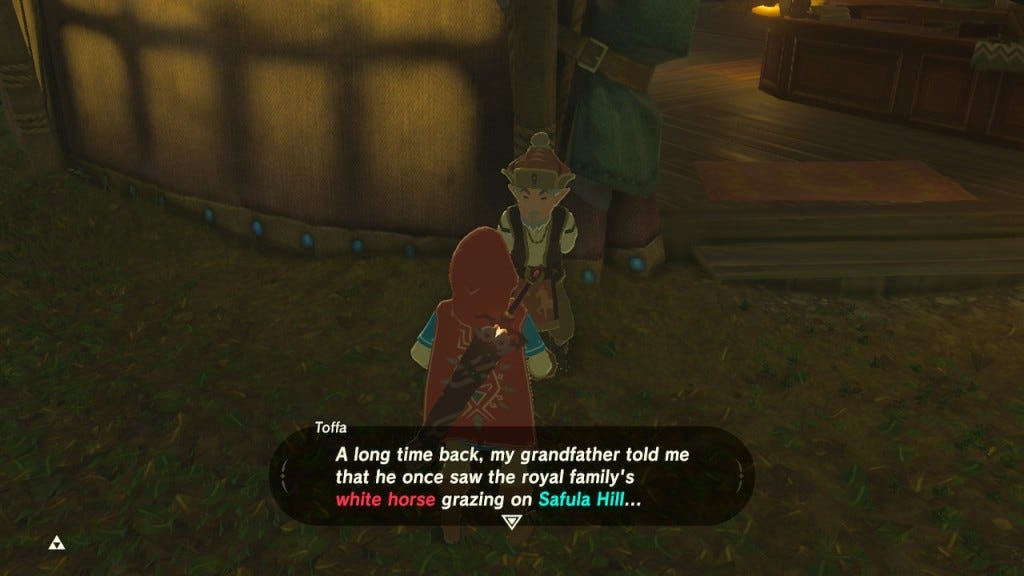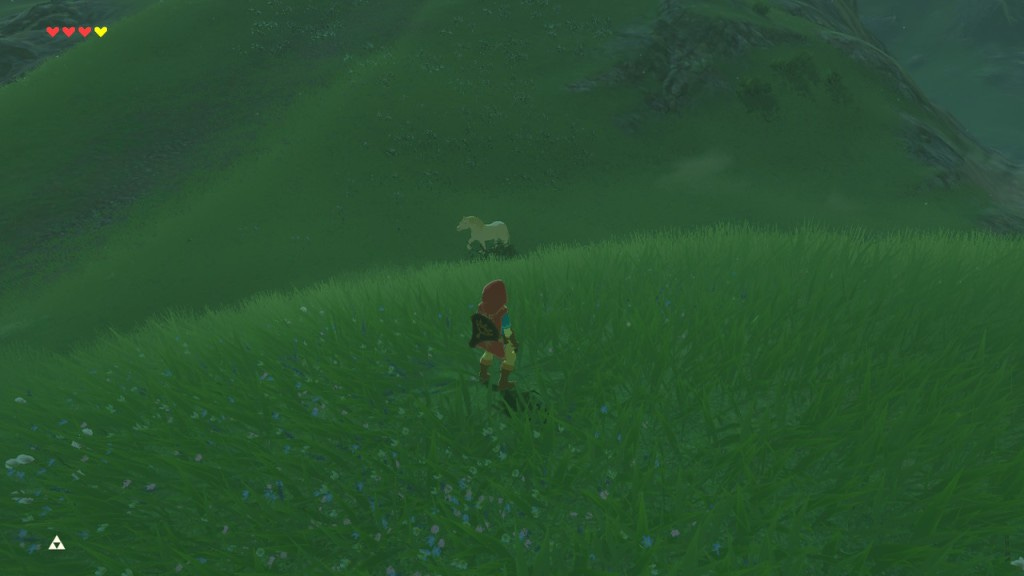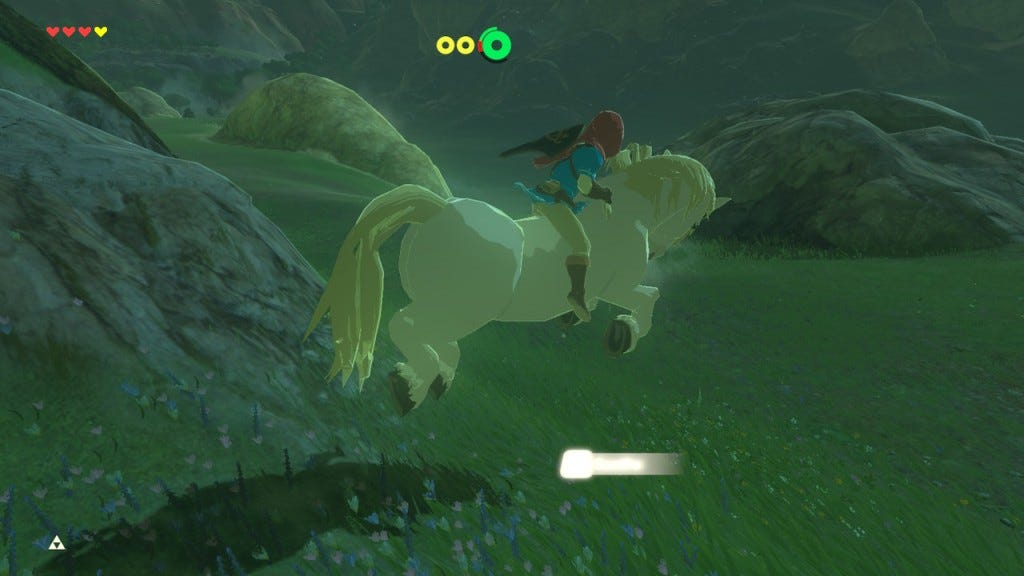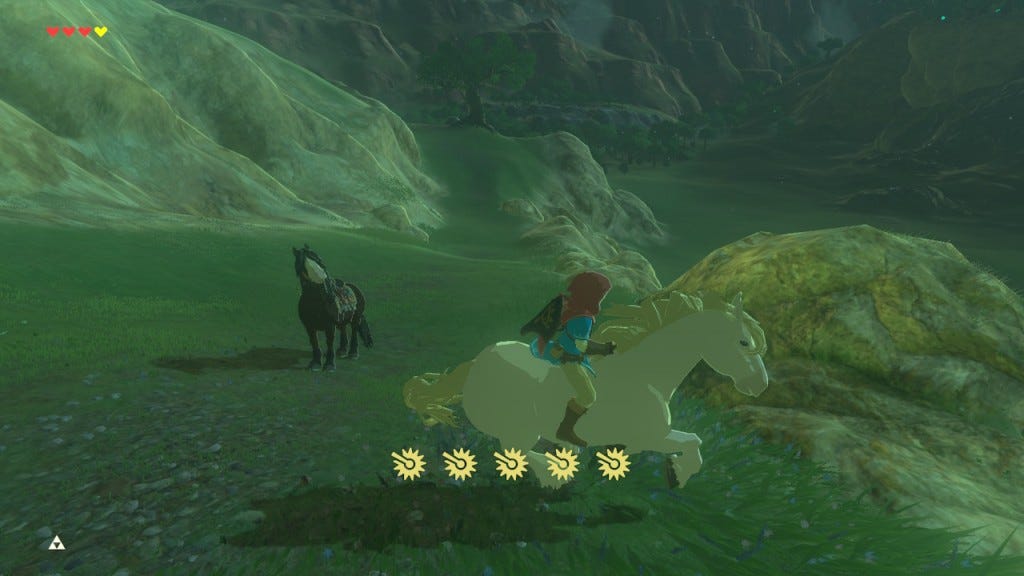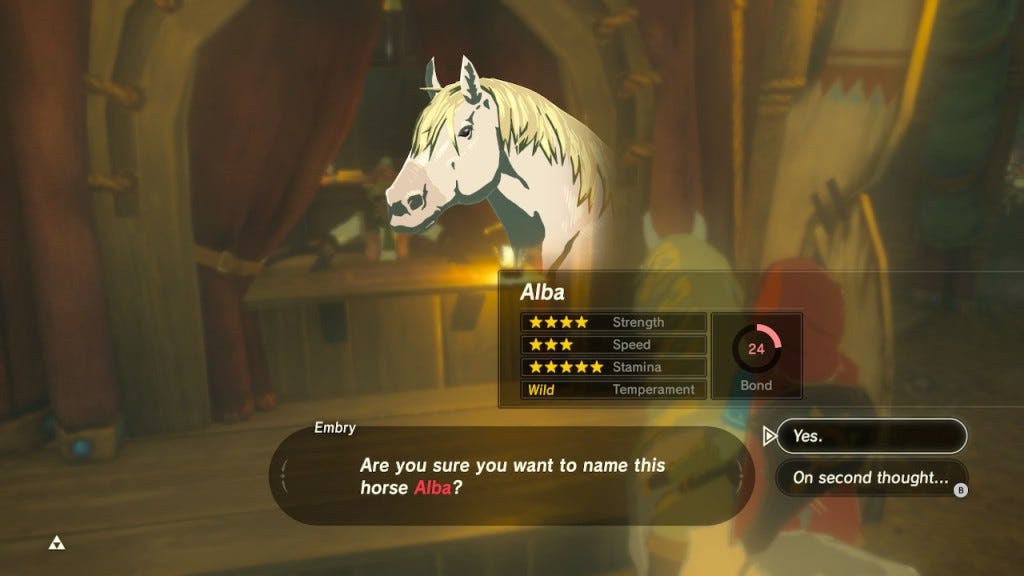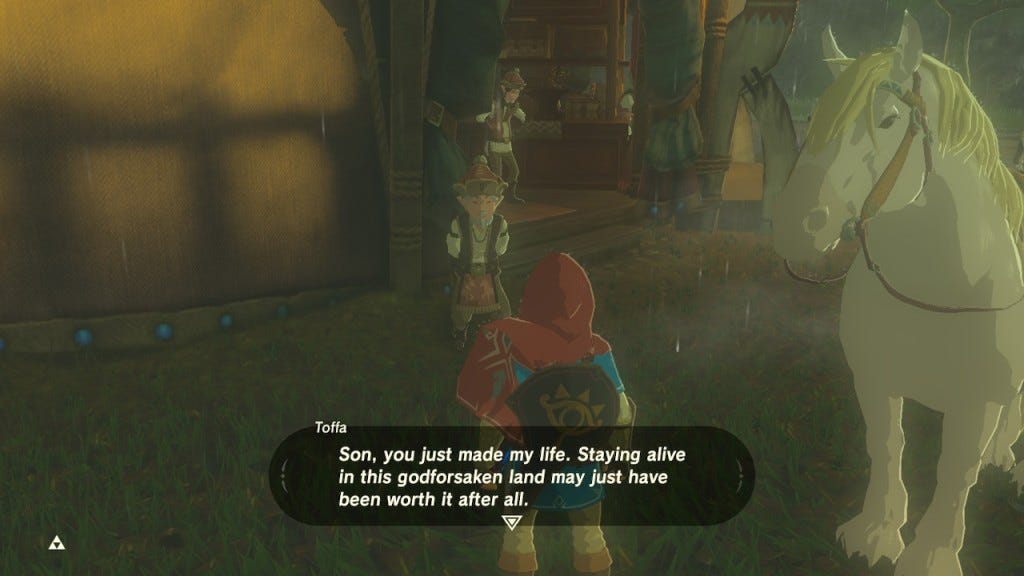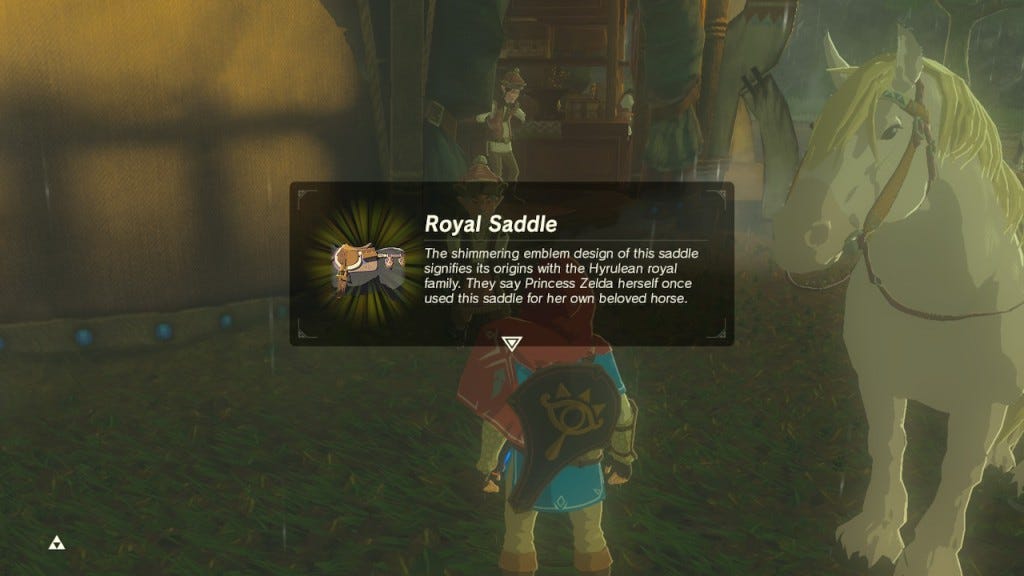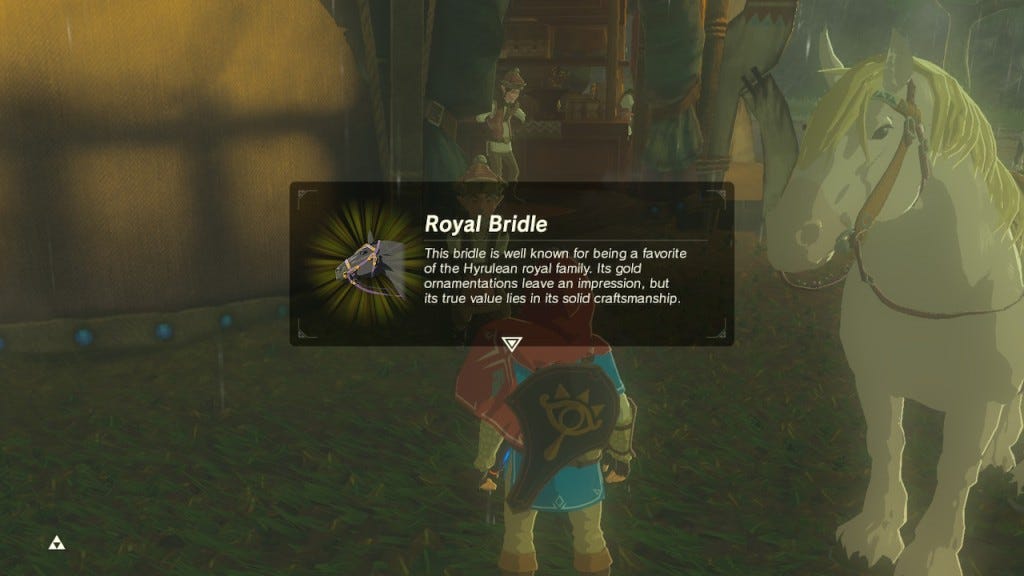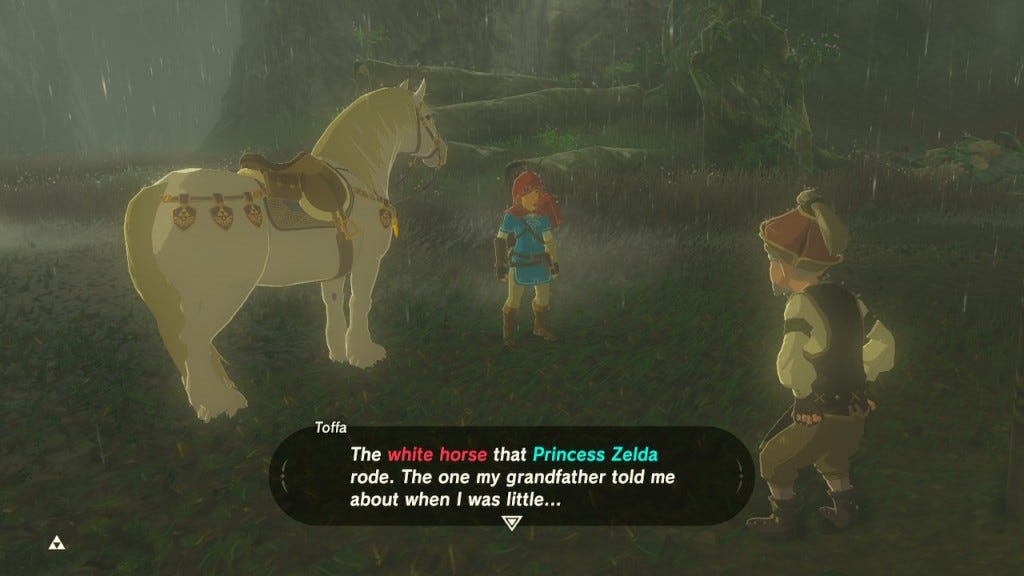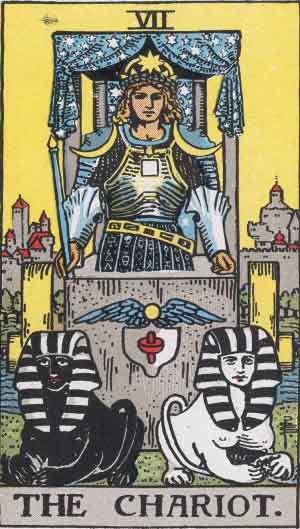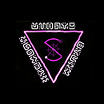In my recent post, Put A Fork In It, I both found and then introduced the "Great Plateau Launch Pad," a platform on the Northeast corner of the plateau that symbolizes the crossroads in Link's journey. So far, we have only followed the middle branch, though we've been where the right-hand path eventually leads. Now we're going to explore the more obscure road that branches off to the left: The Royal Road.
Warning! SPOILERS for The Legend of Zelda: Breath of the Wild from here on out!
Turning Left
On a first playthrough, there are likely two reasons a person would take The Royal Road: Either out of curiosity (maybe something over there caught their eye if they went off the beaten path while collecting Spirit Orbs for The Old Man), or if they're compulsively contrarian (some people love doing the exact opposite of everything they're told).
Let's see what happens if we follow the rim of The Great Plateau to see where this road leads:
It looks like there's another wall off to the West; does it mirror the Launch Pad in any way? Let's go over there.
Okay. Looks like our road winds in between this plateau, and one nearby, which houses a ruined Colosseum. Color me intrigued. But let's climb our local wall.
The road is defined by the narrow sliver between these mesas. The distance just beyond and between the gap calls to my heart.
I see something off in the distance...looks like the outline of a horse head. I think it's a stable.
Now that it's raining, it's difficult to see, but yes, it's a stable—close enough to glide to from up here. A shrine also glows near the summit of Satori Mountain.
The Meaning(s) of the Path
"The Royal Road" is another name for the path of Alchemy or The Great Work, which I first formally introduced as a theme in Breath of the Wild in this post. From what I have observed on my journeys, this game is absolutely loaded to the gills with esoteric, mystical, and occult symbolism from all over the world. This has been true of video games for a very long time, damn near since the beginning; I've been spotting the symbols all my life. Sometimes, they even seem to be pointing somewhere, as well. However, this game is so far unique in my experience in terms of just how deep the esoteric rabbit hole goes. It didn't take me long to reach the conclusion that the entire game is laid out with purpose and insight into the ideas represented by all of these symbols. Paths are meaningfully laid out for Link. Hyrule is a labyrinth, with Hyrule Castle representing the center toward which we journey. The farther along I go, the more convinced I am that it was all done on purpose. Whose purpose? That's an interesting question we will be exploring in this post.
Alchemy is a subject that starts out totally opaque to the student (at least, the student who goes beyond viewing it as merely the physical transmutation of lead into gold), but can eventually become so transparent that the student starts to see it everywhere they look. On one level, this is because of just how much alchemists have relied on symbolism, codes and ciphers to conceal (and, paradoxically, to communicate) their secrets. Once a practicing alchemist reaches a certain level of understanding, apart from their own personal studies and experiments in the Art, it's common for them to spend the rest of their lives spreading the message by weaving alchemical symbolism into all of their works. Why do they do this? Only an alchemist can fully understand, but it's because doing so is just as important a part of The Great Work as anything else; the alchemist sees themselves as constantly in development toward Perfection; the alchemical vessel is seen as an allegory of the Self. However, all of the same is also held to be true of the world at large: It, too, is in ongoing development, and according to alchemical principles, it needs our conscious aid in order to do so—nothing will simply happen on its own and this is why it is called The Great Work. The alchemist and the world are in constant interaction with one another, always developing in tandem, each leaning on the other to carry out alternating phases of the work.
The symbolism of alchemy isn't just thick, it's also laid down in countless aligning layers, such that one symbol can and usually does have multiple meanings, both on different levels, and in different contexts entirely. The way alchemical symbols morph, transform, and produce one another cannot be fully grasped through rational thought alone; an alchemist must develop their intuitive faculties as well.
So it is with "The Royal Road," a path with many meanings in Hyrule. There are both literal and symbolic meanings.
In its most literal conception, I first thought of "The Royal Road" in terms of a reverse play order for the game. In both this post and this post, I explore the concept of there being an intended order for freeing the Divine Beasts; when I first thought of "The Royal Road," it was as a type of playthrough in which Link does things in the complete opposite order from the intended order, the reason being because it would be a hell of a lot harder and thus, a challenge "fit for a king."
Another option would be to head in the direction of the Royal Road first to accomplish something in that direction before continuing on with a different, perhaps more "normal" playthrough.
However, there does seem to be a "preordained" time to do this, and in terms of the journey we've taken so far, this post is where that time fits (this mirrors The Great Work itself, wherein there really is no 'wrong' road, but there is a 'right' one that is highly recommended. The only problem is that many alchemists will never work that way because instead of having a master to teach them, we have to find our own way). As readers who have been following along will know, ever since I took the middle road from the Launch Pad on this playthrough, I've been largely playing it by ear and following breadcrumbs (even though I do have a rough idea how this journey will likely be structured). I've been really surprised and happy with what I've discovered so far, and I don't think I would have discovered these things if I weren't writing these posts. This goes to show that if you want to really learn something, you should teach it.
That being the case, let's follow the Royal Road and see what Link finds. As I made the journey, I found 3 main signs that this is "the right time" to do this.
Saddle Up
Once Link receives the Champion's Tunic, he is basically on his own from that point forward. The clearly and explicitly defined path found by following the main quest line has reached its destination. I remember being so lost at this point when I first played the game. However, since this playthrough is doubling as a self-Initiation ceremony and covering The Royal Road now fits in place relative to my personal work, I went there this morning.
The first clue that I was on the right track came when I spotted a Fire Wizzrobe around the corner from Outskirt Stable. In the quest line, The Weapon Connoisseur, the next weapon I need to bring to show Nebb (and leave on the ground for him) is the Fire Rod, which is carried by Fire Wizzrobes. Nebb is just gonna love his new toy!
Reaching Outskirt Stable, Link can talk to the people who work here, including Toffa, an old man who gives him a new quest: Rumor has it that a pure white horse descended from Zelda's very own royal steed is wandering around nearby. Can Link tame it and bring it to Toffa?
Riding his red horse, Ruby, to the location, crossing Manhala Bridge along the way, then dismounting, Link eventually finds the royal stallion.
As with any horse, he sneaks up on it, mounts from behind, and soothes the horse as it tries to buck him off like a bronco.
Then he needs to ride the horse back to the stable to register it, passing Ruby along the way. Awkward.
When Link returns to the stable, he registers and names the horse, then completes the quest with Toffa, who is happy beyond words to see this horse. He tells Link it made his life! In gratitude, Toffa gives Link some very special tack for this horse. Now we're going to talk about more signs that this is the correct timing for this quest.
The Royal Stallion is an alchemical symbol. For one, it's a purebred horse with a solid pedigree, which is in keeping with The Art of Kings, alchemy. Second, the horse is "pure white," which represents Albedo, the second phase of alchemy. This phase is, in part, about purification, and Link is at the point in the game where he is about to set off on his quest to "purify" the Divine Beasts. This phase also involves the process of "separation," which we will explore next.
Solve
While Link was taming Alba, he was really close to one of the locations holding a Captured Memory: Sanidin Park Ruins. Since it's right there, we might as well go take that memory in. When I went to collect it and watch it this morning, I cried a little this time. I'm still puzzling out why that was. It was emotional to watch, I'm not sure why.
There's one last thing to scope out before I wrap this post up: The third clue that the timing here is just right.
There are 15 stables throughout Hyrule, and for the sake of convenience, I reckon (since you can teleport to any Sheikah Shrine you've activated), there's a Sheikah Shrine close to each one. I've noticed that the names of these Shrines seem meaningful on occasion. I never did figure out a meaning for the name of the Shrine by Outskirt Stable—that is, until this morning, when I had the context of where I was about to go. The name is a clue to something else, as well.
The Shrine is named Rota Ooh Shrine, and the name of its trial is meaningful, too: "Passing of the Gates." What Gates? Probably Initiatory Gates; like I said, we just finished the first quest line in the game that symbolizes Link's growth into adulthood, and now he's about to set out on his quest in earnest. This is perfection.
So how about "Rota Ooh?" It means exactly what it sounds like! "Rota" is the Latin for "wheel," and the first Divine Beast is found in the wheel-shaped city of Zora's Domain. We also find the word "ROTA" on the Tarot Trump, Wheel of Fortune. Here, among other things, because of the way the word is arranged in a wheel that rotates back to itself, the letters can also be taken to spell out "TAROT." This is a clue to one of this game's deepest mysteries. It answers the question people have been asking since The Legend of Zelda came out: "Why the hell is the game called 'Zelda' when it's about Link's quest?"
One mystery of the 22 Trumps of the Major Arcana is that every single figure and every single symbol in every single card can be taken as a symbol of the Self, or some part of the Self. In this sense, then, Link and Zelda are twin aspects of the same person. Put together, they become the Divine Androgyne. Thus, as far as the Hero's Journey is concerned, these snippets revealing parts of Zelda's story are revealing lessons about The Hero's Journey that are just as important as Link's escapades.
Speaking of tarot trumps, all of the themes of this post can be summed up in one card—"for those who have eyes to see:"
Postscript:
I mentioned above that I would address "whose purpose" this labyrinth may serve. There are already clues in this post; Satori Mountain figures into the background of at least one photo and I have mentioned it by name. Honestly, I second-guessed myself. That said, a sign from the universe had me chewing on this while I took a shower, and I realized I needed to commit. My #1 theory for who "The Alchemist" is? Former Nintendo President, the late Satoru Iwata. Satori Mountain and the entire area surrounding it is a loving tribute to a brilliant man who brightened the lives of not only everyone around him, but generations—plural—of gamers. The least I could do in gratitude is turn his game into a resource for generations of people to learn a thing or two about the real magic of gaming. Below is a video all about it, made with just as much love by one of my favorite YouTubers, Croton.
On my business card, I am a corporate president. In my mind, I am a game developer. But in my heart, I am a gamer.
Satoru Iwata


